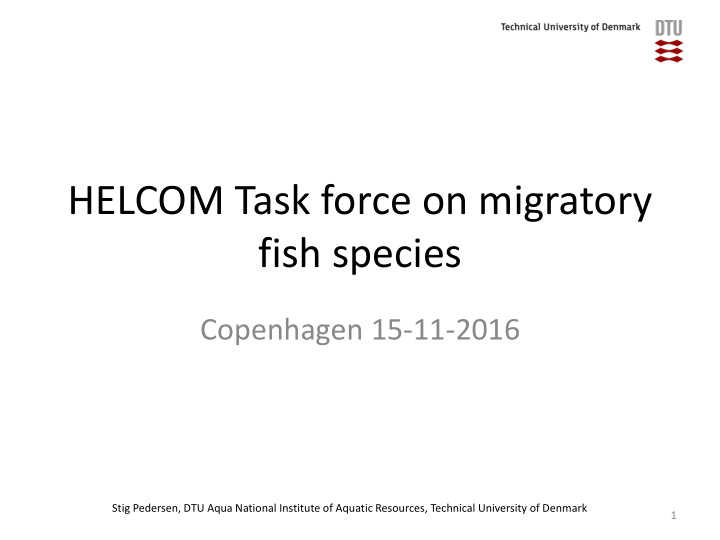



HELCOM Task force on migratory fish species Copenhagen 15-11-2016 Stig Pedersen, DTU Aqua National Institute of Aquatic Resources, Technical University of Denmark 1
Danish streams • Stream length 70,000 km • Lowland streams • Majority of streams small (by length ca. 59 %) • Good chemical water quality • High productivity • General increase in quality over past 30 years • Physical stream conditions formally regulated for each river stipulating shape, maintenance scheme etc. 2
Anthropogenic influences Allmost all streams (98%) affected by man: – Ditching, straigthening, culverting • purpose: land use and regulation of water level in farm land – Construction of barriers • Purpose: energy, fish farming – Maintenance • Purpose: Ensure draining and avoiding flooding 3
Major effects from anthropogenic actions • Straightening – Increased / changed slope – Increased erosion – Increased content of fine sediment (sand) – Lack of gravel for salmonid spawning – Reduced productive area • Construction of barriers – Inhibiting migration – Changing stream conditions up and downstream • Maintenance – Affecting biological content and diversity – Affecting shape and flow – habitat composition and content 4
Restoration methods used • Straightening – Re-meandering – effect on potentially all elements – Addition of gravel – salmonid spawning – Establish sand traps – Establish wide river banks without culture • Construction of barriers – Establish fish ladders – Establish nature like by-passes – Complete removal of barriers • Maintenance – Shading to reduce growth of stream vegetation – Selective / network / main current path cutting of vegetation – Reduce intensity of weed cutting 5
Remeandering 1954 River Gels Å 1989 2015 6
Remeandering and creating nature like by-pass at fish farm River Storå 7
‘Natural’ by -pass at fish farm River Storå 8
Loss of smolt at downstream migration past barriers Barrier type Avg. Smolt loss (%) Mills (n=5) 30 Fish farms (n=38) 42 Hydro power plants (n=7) 82 9
Smolt loss in streams and reservoirs River Reservior/Lake N=8 50 Smolt loss km-1 (%) 40 N=10 30 20 10 N=8 N=4 0 Trout Salmon 10
Barriers - Loss of habitat + elevated smolt mortality 11
Loss of gradient in weirs Aarestrup & Koed 2006 12
Removal of barriers – Villestrup Å Number of smolt 2 – 7’th Barrer removed 1. Barrier removed 13
14
15
Before and after removal of weir in Kolding Å 16
Before and after removal of weir in Kolding Å 120 100 Density of 0+ trout 80 60 40 20 0 2008 2009 Removal of barrier resulted in appox. 300 spawning sea trout in first winter and trout densities in upstream sites increased approx. 5 times 17
Restoration on a smaller scale Addition of spawning gravel – also increases habitat variation Many small projects by NGO’s (angler associations) Financial support from the Fish Care Management program Annual budget 65,000 EURO 18
Restoration on a smaller scale 19
Restoration on a smaller scale Reduced maintenance and erosion 20
The Fish Care Management programme • Funded by a national • Objective: license from Forward natural – Anglers: 25 EURO / year reproduction of fish populations – Recreational fishermen – Stocking (fixed gear): 40 EURO / – Habitat improvement year – Management initiatives – Research 21
Plans for Fish Care • 7000 sites monitored every 7-8 years (1000 sites /year) • 70 % of sites are fished 22
Plans for fish care • Publish a report for each river or group of smaller rivers • Recommendations issued with focus on habitat improvement • Stocking of trout only with local strains in order to reintroduce (and enhance) populations 23
Distributing information + two fulltime consultants advising both NGO’s and authorities 24
25
26
27
Recommend
More recommend